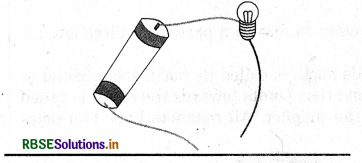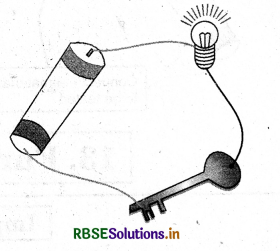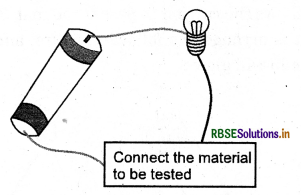RBSE Class 6 Science Important Questions Chapter 12 Electricity and Circuits
Rajasthan Board RBSE Class 6 Science Important Questions Chapter 12 Electricity and Circuits Important Questions and Answers.
Rajasthan Board RBSE Solutions for Class 6 Science in Hindi Medium & English Medium are part of RBSE Solutions for Class 6. Students can also read RBSE Class 6 Science Important Questions for exam preparation. Students can also go through RBSE Class 6 Science Notes to understand and remember the concepts easily. Browsing through class 6 science chapter 4 extra questions that includes all questions presented in the textbook.
RBSE Class 6 Science Chapter 12 Important Questions Electricity and Circuits
Multiple Choice Questions
Question 1.
The filament of a bulb is made up of:
(a) iron
(b) chromium
(c) tungsten
(d) silver
Answer:
(c) tungsten

Question 2.
An example of insulator is:
(a) Aluminium
(b) Rubber
(c) Iron
(d) Silver
Answer:
(b) Rubber
Question 3.
A conduction tester test:
(a) whether the given object is a conductor or insulator
(b) the magnetic property of a given material
(c) the impurities present in water
(d) all of these
Answer:
(a) whether the given object is a conductor or insulator
Question 4.
Which of the following is an insulator?
(a) Seawater
(b) Distilled water
(c) Tap water
(d) None of these
Answer:
(b) Distilled water
Question 5.
Which of the following is not true about electric cells?
(a) Chemical energy is converted into electrical energy.
(b) It has a neutral terminal.
(c) It has a positive terminal.
(d) It has a negative terminal.
Answer:
(b) It has a neutral terminal.
Question 6.
In an electric bulb, light is produced due to:
(a) the glass case of the bulb
(b) the gas inside the bulb
(c) the thick wires supporting the filament
(d) the thin filament
Answer:
(d) the thin filament
Fill in the Blanks
Question 1.
The two terminals of a cell are .................. and ..................
Answer:
positive, negative
Question 2.
An electric cell produces ..................
Answer:
electricity
Question 3.
The direction of the current is from .................. to ..................
Answer:
positive to negative
Question 4.
When the electric bulb does not glow it is said to be ..................
Answer:
fused
Question 5.
A combination of two or more cells is called a ..................
Answer:
battery
State whether True or False
Question 1.
The bulb has one terminal.
Answer:
False
Question 2.
Copper is a bad conductor of electricity.
Answer:
False
Question 3.
Metal cap of an electric cell is a positive terminal.
Answer:
True
Question 4.
Tungsten has a high melting point.
Answer:
True
Question 5.
When the positive of the bulb is connected with the negative cell and the negative of the bulb is connected with the positive of the cell, the bulb does not glow.
Answer:
False

Match the followings
|
Column I |
Column II |
|
1. Electric circuit |
(a) check whether the material is conductors or insulators |
|
2. Bulb |
(b) filament |
|
3. Insulator |
(c) breaks the circuit |
|
4. Switch |
(d) gives path to the flow of current |
|
5. Cell |
(e) cells are connected in series |
|
6. Torch |
(f) converts chemical energy into electric energy |
|
7. Tester |
(g) plastic |
Answer:
|
Column I |
Column II |
|
1. Electric circuit |
(d) gives path to the flow of current |
|
2. Bulb |
(b) filament |
|
3. Insulator |
(g) plastic |
|
4. Switch |
(c) breaks the circuit |
|
5. Cell |
(f) converts chemical energy into electric energy |
|
6. Torch |
(e) cells are connected in series |
|
7. Tester |
(a) check whether the material is conductors or insulators |
Very Short Answer Type Questions
Question 1.
What are the two terminals of a cell called?
Answer:
The two terminals of a cell are positive and negative terminals.
Question 2.
What is the correct way of connecting the cells?
Answer:
A positive end of one cell should always be connected to the negative end of the other cell.
Question 3.
Name some devices in which we use electric cells?
Answer:
We use electric cells in torch, watch electric toys, camera, mobile, etc.
Question 4.
When we pass electric current through any device, why does it become hot?
Answer:
It becomes hot because electric energy gets converted into heat energy.
Question 5.
What are the components of an electric circuit?
Answer:
The components of electric circuit are cell or battery, wires, bulbs, and switches.
Question 6.
What is the open circuit?
Answer:
An electric circuit in which the path of the current is disconnected by breaking a circuit is called open circuit.
Question 7.
What is the close circuit?
Answer:
An electric circuit in which the current can flow without any interruption in its path is called a close circuit.
Short Answer Type Questions
Question 1.
What will happen if we join two terminals of an electric cell directly through a wire?
Answer:
If we join two terminals of an electric cell directly through a wire, the chemicals present in the electric Cell gets used up very fast and the cell Will stop working.
Question 2.
What is a battery?
Answer:
When two or more cells are joined together, it is called a battery

Question 3.
Explain how the bulb glows in a circuit when it is connected to an electric cell?
Answer:
When a bulb is connected to the electric cell in a circuit, a current pass through the filament of the bulb and it makes the bulb glow.

Question 4.
Why does an electric bulb get fused?
Answer:
An electric bulb gets fused due to the break of its filament. Breaking of the filament of a bulb means breaking the path of current between the terminals of electric cell.
Question 5.
Define electric switch.
Answer:
A switch is a simple device that either breaks a circuit or completes it. For example - in a microwave oven or toy cars we have switches to turn it ON or OFF.
Long Answer Type Questions
Question 1.
Why do the bulbs and cells have two terminals?
Answer:
The bulb glows when the electric current passes through the close circuit. The circuit is said to be closed when its both terminals are connected, hence if the bulb or cell has only one terminal then the circuit will not get completed and current will not be able to flow.
Question 2.
Does the bulb glow in the given figure? If no, then what will be the way to make the bulb glow?

Answer:
No, the bulb does not glow as the circuit is incomplete. If we use the key, as metal is a good conductor of electricity, it allows the current to pass through it. Thus, it is arranged as following figure, and the bulb will glow:

Question 3.
Why should we wear rubber slippers while touching the electrical appliances?
Answer:
Our body being a good conductor of electricity can get electric shock when we touch the electrical gadgets. A rubber slipper cuts off the path of electric current and makes the circuit open. So, we should wear rubber slippers while touching the electrical appliances.
Question 4.
Differentiate between conductors and insulators.
Answer:
Differences between Conductors and Insulators
|
Conductors |
Insulators |
|
Materials which allow electric current to pass through them are known as conductors of electricity. |
Materials which do not allow electric current to pass through them are known as insulators. |
|
For example, Metal coins, iron, aluminum. |
For example, Plastic, wood, rubber. |
|
Uses: Switches, electrical plugs and sockets are made of conductors. |
Uses: Rubber and plastics are used for covering electrical wires and parts of electrical equipment for safety purposes. |

Question 5.
How can we make a tester?
Answer:
A tester tests whether a given material is a conductor or an insulator.

Take few wires, bulb and a cell, connect the cell and bulb with the help of wires. Now, connect the material to be tested between the two ends of the wire as shown in fig. If the bulb glows then the material which we used is a good conductor of electricity. If the bulb does not glow then the material used is an insulator.

- RBSE Solutions for Class 6 Science Chapter 1 भोजन: यह कहाँ से आता है?
- RBSE Solutions for Class 6 Science Chapter 12 Electricity and Circuits
- RBSE Class 6 Science Notes in Hindi & English Medium Pdf Download
- RBSE Class 6 Science Important Questions in Hindi Medium & English Medium
- RBSE Solutions for Class 6 Science in Hindi Medium & English Medium
- RBSE Class 6 Science Important Questions Chapter 16 Garbage In, Garbage
- RBSE Class 6 Science Important Questions Chapter 15 Air Around Us
- RBSE Class 6 Science Important Questions Chapter 14 Water
- RBSE Class 6 Science Important Questions Chapter 13 Fun with Magnets
- RBSE Class 6 Science Important Questions Chapter 11 Light, Shadows and Reflections
- RBSE Class 6 Science Important Questions Chapter 10 Motion and Measurement of Distances